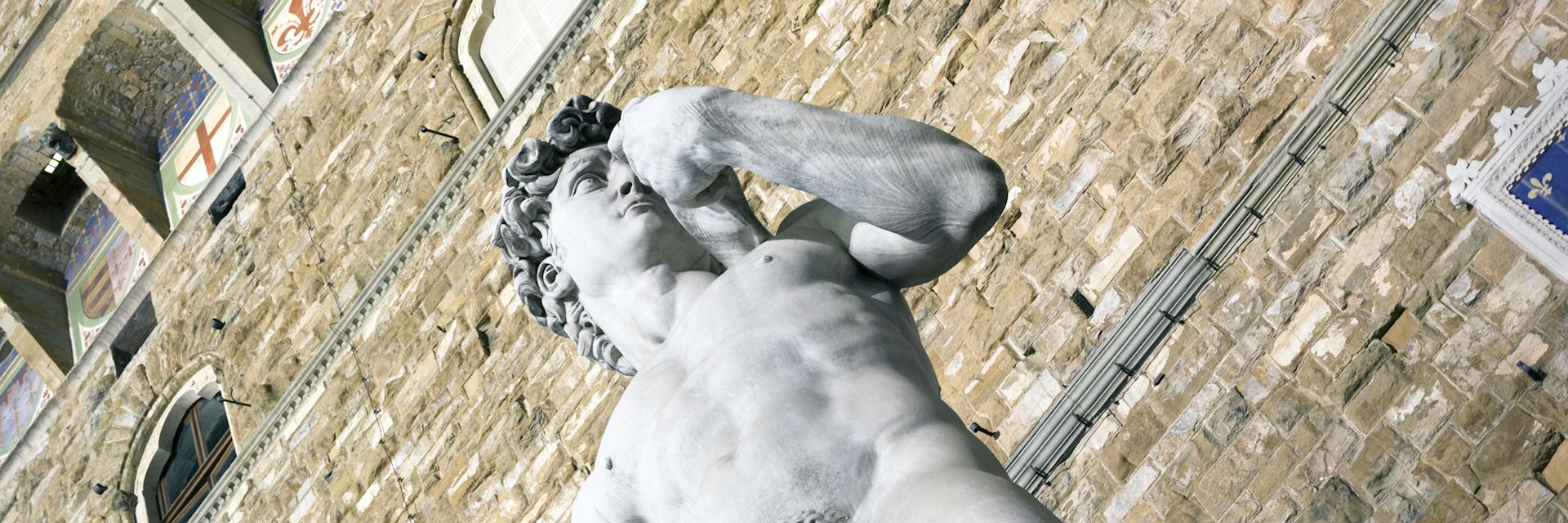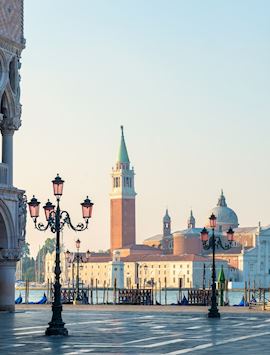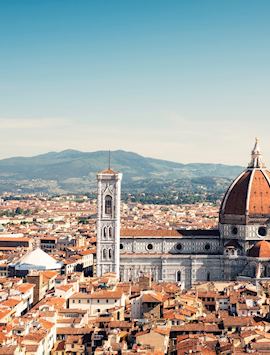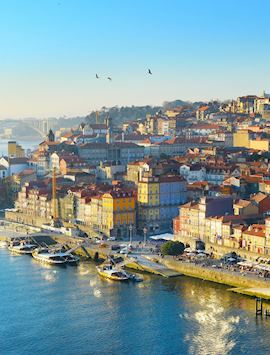Inspired by classical philosophy and art, the Renaissance gave us many of the works that have come to define European culture. Funded by the overflowing coffers of great families, this era represents a flowering of thinking, art, architecture and literature across the continent.
By some calculations, 2019 is the 500th anniversary of the Renaissance. To celebrate, we’ve compiled a list of both blockbuster sights and lesser-known pleasures in six of the cities that helped define the era. Consider these as simply inspiration for your own trip, whether you’re looking for an in-depth examination of Italy’s Art Cities or a grand tour that follows the life and works of Leonard Da Vinci.
Michelangelo, the Medicis and gardens in Florence
By Italy specialist Madeline

With elegant brick buildings and graceful bridges, as well as the marble-clad Duomo, Florence’s well-preserved historic core is practically an open-air museum dedicated to the Renaissance. That’s fitting, since this wealthy city state was the artistic powerhouse of the era, thanks to the patronage of the Medici family.
Must-see sights: The Galleria degli Uffizi holds the world’s foremost collection of Italian Renaissance art, donated by the Medicis in the 1700s. You’ll see works by all the era’s biggest names, including Michelangelo, Raphael, Da Vinci and Donatello, as well as a whole room of Botticelli paintings.
A short walk away, the Accademia Galleries hold Michelangelo’s David. A guided tour of both museums can help focus your attention amid the frenzy of remarkable art that’s vying for your attention.
But don’t miss: David commands your attention when you first enter the Accademia, but don’t let the sculpture’s power distract you from Michelangelo’s Prisoners, several unfinished torsos. Almost modern in their execution, these subjects seem to struggle to break out of the surrounding marble.
Dig deeper: Also funded by the Medici clan, Boboli Gardens are one of the earliest examples of a formal Italianate garden. A veritable outdoor museum, it’s a peaceful place to wander as you admire the restored hedges, fountains and flower beds.
Popes, palaces and a painting class in Rome
By Italy specialist Eva

Just as the Medici family funded the great works of Florence, the Vatican’s patronage powered the Renaissance in Rome. The city’s architecture is not purely Renaissance, like that in Florence, but there are still plenty of churches from the period dotted across the city.
Rome’s greatest architect of the movement was Bramante, whose designs include the transcendent Tempietto. Clearly inspired by Greek temples, this perfectly proportioned ‘little temple’ is a delightful surprise built on the very spot where Saint Peter was crucified.
Must-see sights: The blockbusters at the Vatican Museums — Michelangelo’s works in the Sistine Chapel and Raphael’s frescoes — all date from the Renaissance. Though those rooms are often crowded, the works retain a certain power when you see them in situ.
However, as one of Europe’s greatest artistic collections, the museum also hold works from every period of human history. A guide can help you trace the classical antecedents to the Renaissance, including the Belvedere torso, a Roman-era piece that served as a model for Michelangelo’s risen Christ in the Last Judgement.
But don’t miss: There’s so much to see in Rome that it’s easy to overlook its smaller museums, but the Doria Pamphilj Gallery is worth seeking out. This Renaissance palazzo displays the accumulated private collection of the Doria, Pamphilj, Landi and Aldobrandini families, and the densely packed galleries include works by Bernini, Raphael and Caravaggio.
I suggest picking up the audio guide, which is narrated by the family’s current scion, Jonathan Doria Pamphilj.
Dig deeper: Dynamically lit and drenched in red, Caravaggio’s works marked the end of the Renaissance, and the transition to Baroque. Explore his distinctive style on a guided tour of small churches that feature his works, followed by a private painting class to learn his techniques.
Leonardo’s last home in Amboise, France
By France specialist Aislyn

France’s Renaissance-era architecture found its pinnacle in the Loire Valley, where nobles built turreted confections from white limestone, often surrounded by elaborate gardens. When you explore the area, I suggest staying in the centrally located town of Amboise, where Leonardo da Vinci lived out his last days.
Must-see: Da Vinci moved to Amboise at the invitation of his royal friend, François I, who hoped to kickstart in France the same resurgence of art and thought that he saw in Italy. Da Vinci lived at Château du Clos Lucé, a (comparatively) modest manor in Amboise where he spent his final three years tinkering, sketching and innovating under the patronage of the king.
Today, you can visit the room where the polymath died and see his workrooms, while children can clamber over scale models of his many inventions in the manor’s extensive gardens. Look for the then-secret tunnel to the castle that François had built so they could visit in private.
But don’t miss: Château d'Amboise looms over the riverside from a rocky escarpment. Built in a mishmash of styles, the palace isn’t strictly Renaissance, the way that some of the nearby chateaux are. However, it’s home to the tiny Chapelle Saint Hubert, where Leonardo da Vinci was laid to rest in 1519.
Dig deeper: We can arrange driving tours of the many stately chateaux that dot the valley. Perhaps the most impressive is Château de Chambord, an hour east of Amboise. The enormous castle boasts a double spiral staircase, possibly designed by Da Vinci himself.
The Mona Lisa and Petit Palais in Paris
By France specialist Leanne
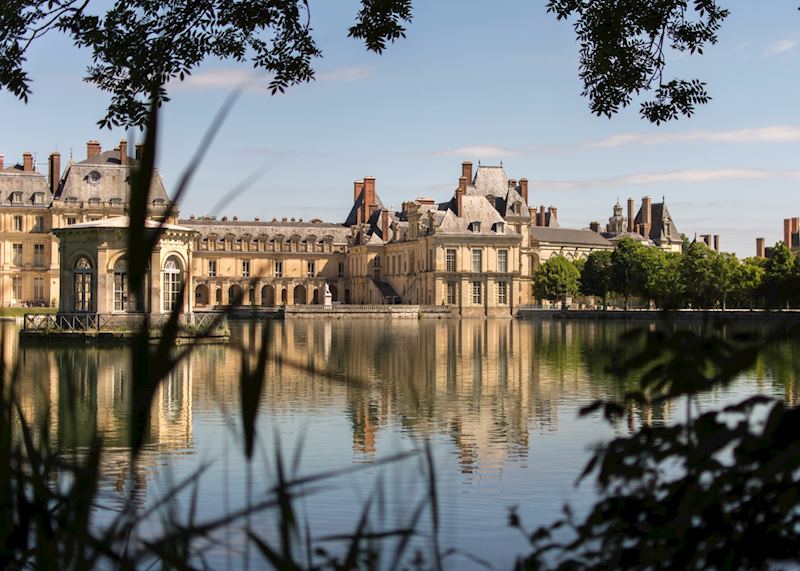
Paris doesn’t have many Renaissance-era buildings still standing. Aside from Pont Neuf, Place des Vosges is one of the few architectural remnants of the era — we can arrange a walking chocolate-and-pastry tour of the Marais district that takes in the square’s elegant proportions. However, if you know where to look, you can still find echoes of the Renaissance elsewhere.
Must-see: The Louvre is one of the few European museums that boasts a larger art collection than the Vatican. It’s also home to Da Vinci’s Mona Lisa, which competes with David as the most recognisable piece of art from the Renaissance.
The crush of visitors there to see the museum’s best-known piece can detract from your viewing pleasure. That’s why I suggest an evening visit with a private guide — crowds are much thinner, and you’ll get to ponder her secretive smile in relative peace.
But don’t miss: In this city with 130 museums, it’s easy to overlook the Musée des Beaux-Arts de la Ville de Paris, but if you’re interested in the Renaissance, it’s worth a few hours of your time. Housed in the Petit Palais, just a short stroll from the Louvre, its exhibits include an extensive collection of Renaissance-era objets d'art. You’ll see Moorish ceramics, illuminated books, Venetian glass, glazed earthenware and enamels from Limoges, as well as paintings and drawings.
Dig deeper: Arguably the first Renaissance palace in France, Château de Fontainebleau makes a pleasurably bucolic day trip from the city. More than 30 French kings — and the Mona Lisa — have resided here, surrounded by Italianate gardens commissioned by François I.
The Bard in London and beyond
By UK specialist Elizabeth

The Renaissance took a while to wash up on the shores of the British Isles. But, when it finally arrived, it acted as a catalyst for a great flowering of drama and poetry, including the works of Francis Bacon, John Donne, Christopher Marlowe and, of course, William Shakespeare.
Must-see: The original Globe Theatre burned down in Shakespeare’s lifetime, but the recreation gives you a chance to see his works as the author intended — in the round. The half-timbered replica is located near the Millennium Bridge and Tate Modern Museum, and you can take a guided tour, led by a member of the company that performs here.
But don’t miss: For a Shakespeare-themed side trip, we suggest spending a full day in Stratford-upon-Avon. You can explore Shakespeare’s birthplace, school and church, as well as the town’s Tudor houses, thatch-roof cottages and elegant restaurants. You can also take in a performance by the Royal Shakespeare Theatre, which is based here, and get a behind-the-scenes tour.
Devout lovers of the Bard might also consider a visit to nearby Mary Arden's Farm, his mother’s childhood home, as well as Anne Hathaway’s cottage, his wife’s childhood home.
Dig deeper: The Queen of England holds the single largest assemblage of Da Vinci’s sketches and drawings — around 500 of them, kept together as a single collection since his death in 1519. You can currently see about 200 of them on display at the Queen’s Gallery in Buckingham Palace, from July to September.
Scholars and sandstone splendour in Salamanca, Spain
By Spain specialist Julie

In the 16th century, a new wave of thinking by Spanish and Portuguese theologians was coined by the School of Salamanca, after its epicentre at the country’s prestigious university. The Castilian city is therefore an appropriate place to examine the Spanish Renaissance.
Must-see: Spain’s preeminent university since its founding in the 12th century, the school reached its pinnacle during the 16th century, when it was a beacon of humanist thought. Theologian Luis de León lectured here, both before and after his arrest by the Inquisition for the crime of translating some of the Bible into Castilian. After his five-year sentence, when he resumed his place at the lectern, he began, ‘As I was saying…’
On a tour of the university, you can visit the lecture hall named after the fractious friar and hear a recorded recreation of one of his lectures. On the same tour, be sure to look for the tiny frog perched on a grinning skull on the richly ornamental façade — the students consider it a good-luck charm.
Don’t miss: Thanks to its proximity to a sandstone quarry, Salamanca was also the heart of plateresque architecture, a distinctively Spanish Renaissance style that took advantage of the easy-to-work stone.
The style is distinguished by a profusion of stone-carved flowers, festoons and fantastical creatures. On a walking tour of the city, you can see examples of the style across the city, including the Casa de las Conchas, several convents and the prosaically named New Cathedral.
Be sure to look for the astronaut floating among acanthus leaves on the cathedral’s façade — a sly joke by stone masons during a 1992 restoration.
Dig deeper: To really appreciate the golden glow of the aged sandstone and the broad sweep of the city’s architecture, consider climbing to the top of the Old Cathedral’s medieval towers, known as Ieronimus.
Read more about trips to Europe
Start thinking about your experience. These itineraries are simply suggestions for how you could enjoy some of the same experiences as our specialists. They’re just for inspiration, because your trip will be created around your particular tastes.
View All Tours in Europe
